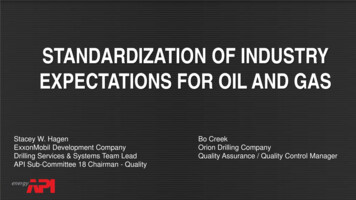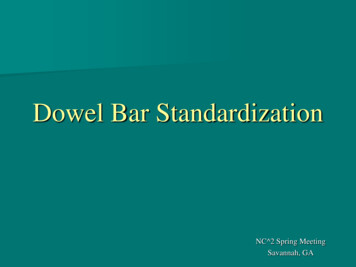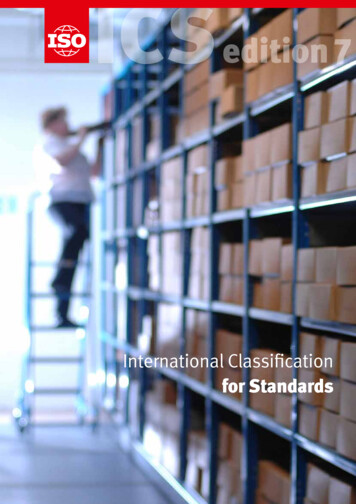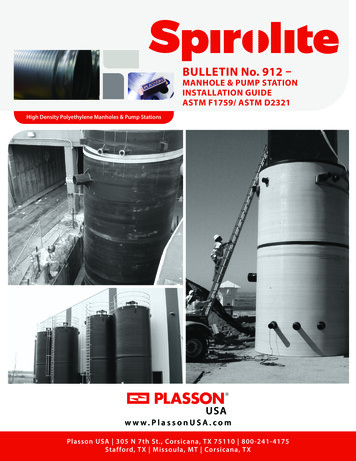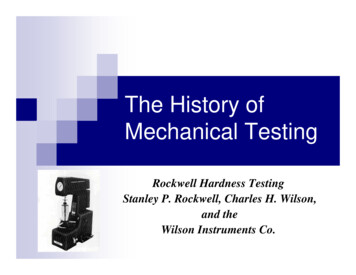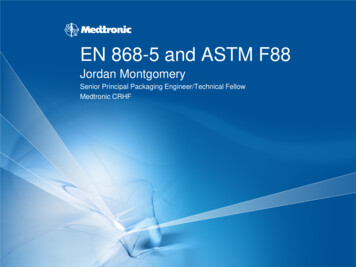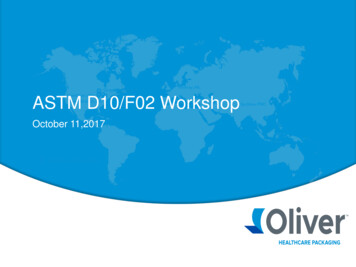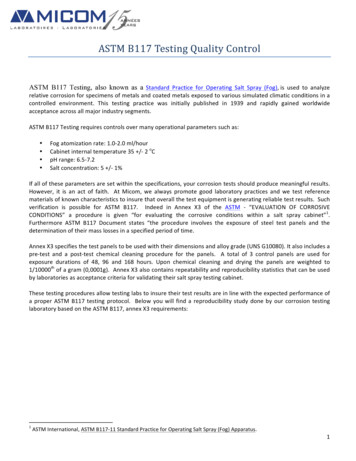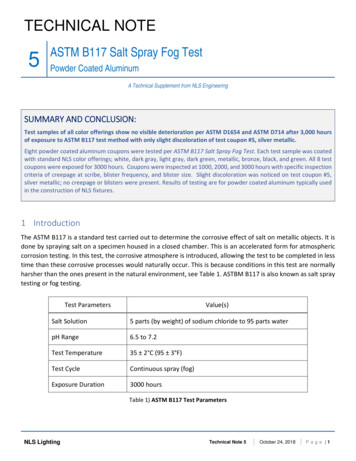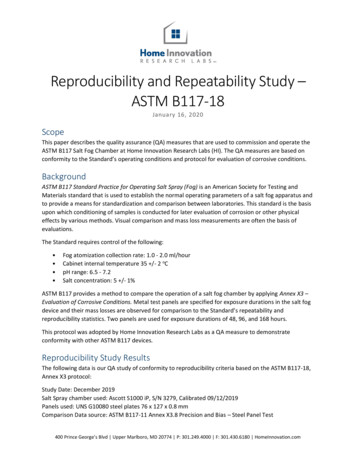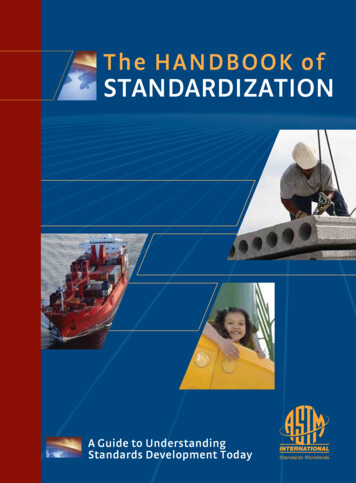
Transcription
The HANDBOOK ofSTANDARDIZATIONA Guide to UnderstandingStandards Development Today
The HANDBOOK ofSTANDARDIZATIONA Guide to UnderstandingStandards Development TodayStandards are a fundamental part of our daily lives for amultitude of reasons. They open channels of communicationand commerce, promote understanding of products, ensurecompatibility, enable mass production and, most importantly, they formthe basis of achieving better health and safety and a higher quality of life.// 3
We are literally surrounded by standards. The buildingswe live in, the airplanes we fly on, the roads we travel, thecomputers we operate, even the clothes we wear are allmanufactured in accordance with standards. All these thingswork smoothly and efficiently if the standards to which theywere manufactured were properly developed and applied.Because of the increasing importance of standards,this booklet has been developed to provide a betterunderstanding of how and why standards are initiatedand used. It explains how standards are developed bythe private and public sectors, and gives an overviewof the major organizations involved with standards.When examples are given to illustrate a point, ASTMInternational will be cited. ASTM International is oneof the world’s largest and most diverse standardsdeveloping organizations (SDOs). pWhat Is a Standard?A standard is a common language that promotes the flow of goodsbetween buyer and seller and protects the general welfare. One examplecomes from building design. When architects design a building,they stipulate exactly what steel is required by referencing a standardspecification on the drawing. They may, for example, refer to “ASTMA 36,” which is a specification for structural steel. This one documentis the simplest and best possible way to communicate to a contractorthe type of steel desired in terms of composition, strength, and quality.ASTM Specification A 36 is a four-page publication describing therequirements that the steel must meet. Using standards, architects donot have to consult volumes of reference books and expend reams ofpaper and costly hours describing steel thickness, tensile strength, andother characteristics.Thousands of such standards are readily available, and thanks to thecommon language of standardization, buyer and seller have littledifficulty communicating. p4 //Consumer Healthand Safety:Made Possible byASTM StandardsASTM standards are all around useach and every day from the waterwe drink, the roads we drive on, thebuildings we live and work in, andthe products we use. For countlessASTM standards, the principal focusis helping to facilitate and protect thehealth and safety of consumers. Manynew standards activities within ASTMInternational bring this longstandingobjective to the forefront.
How Do VoluntaryStandards Get Written?A full consensus standard is developed by a cross-sectionof stakeholders with an interest in its use. When there isa need for new standards, requests can come from tradeassociations, government agencies, and professionalsocieties that do not create their own standards, ormanufacturers, consumer groups, and even individuals.The exact process of forming technical committees anddeveloping and approving the draft standard varies fromSDO to SDO.Generally, standards-writing committees are groups ofexperts who volunteer their time in draft-developmentsessions. They are seeking the mutual benefit of allconcerned through consensus. As an illustration of howSDOs develop standards, we’ll follow the ASTM system.The diversity of ASTM International’s membership isperhaps its most distinct quality and is a large part ofwhat distinguishes the ASTM development and approvalprocess from other organizations.To better help the millions of people living with hearingloss, ASTM Committee F04 on Medical and SurgicalMaterials and Devices is working to advance thetechnology of implantable hearing devices through theefforts of a new subcommittee. Activities addressingsafety issues can be found in the work of ASTMCommittee F24 on Amusement Rides and Devices. Forover 25 years, F24 has created numerous amusementride-related safety standards and has focused recentefforts on standards for the popular areas of water ridesand bungee units.Developing standards at ASTM means working alongsidecompetitors, customers, regulatory bodies, and otherstakeholders from around the world to debate technicalissues, share research data, and exchange knowledge.Through the ASTM International process, thesestakeholders learn to capitalize on their diversity andwork in partnership with each other to resolve theirdifferences during the standards development processrather than after. Coupled with this cooperative systemof standards development is the ensuring of fairnessthrough:1) a required balance of interest between producers, users,and general interest members and2) a voting process that ensures due process.The ASTM process transcends what entities can doindividually because it bridges gaps of technology,combines resources, and overcomes competition. Theresult is a product of the highest credibility, integrity, andmarketplace acceptance.The work of many ASTM committees helps creategreater health and safety for our children throughmyriad product-related standards. As new areas ofconcern arise, ASTM committees such as CommitteeF15 on Consumer Products are quick to address theneed for new standards activities. One example is theefforts of ASTM Subcommittee F15.29 on PlaygroundEquipment for Public Use, which recently releasedan update to Specification F 1487, Consumer SafetyPerformance Specification for Playground Equipmentfor Public Use. Specification F 1487 is an integralpart of the National Playground Safety Institute’splayground inspector certification program. F15 alsohas recently launched new standards for pool andspa safety covers, permanent barrier fencing, andpool alarms, better protecting children in their use ofresidential pools. p// 5
Partnershipfor a BetterEnvironment: ASTMResponds to the CallPromoting a cleaner and safer environmenthas been an enduring focus of numerous ASTMtechnical committees. Through the work ofthese committees, ASTM standards contributeto cleaner air and water, improved wastemanagement and recycling, pesticide safety,hazardous substances and oil spill response,and many other critical areas.As new technologies increasingly play a rolein the ongoing health of our environment, ASTMInternational made a valuable new contributionto environmental safety by developing anew standard that defines pure biodiesel, analternative fuel.The ASTM standard, D 6751, aids manufacturersin their production of biodiesel, as well asproviding users with a full consensus standardthat they can reference in the sale or purchase ofthe alternative fuel. pUnderstanding the hierarchy within ASTM Internationalis integral to appreciating the value of the ASTMstandards development and approval process. Thehierarchy comprises three basic levels: main committees,subcommittees, and task groups. Task groups perform mostof the “leg-work” and research that forms the basis of draftstandards. Once the group completes its work, it forwardsthese drafts through the hierarchy for review and voting.The standard must gain subcommittee, main committee,and Society approval before becoming an official ASTMInternational standard.At each level, voting requirements are enforced to ensurefairness. When the draft has been reviewedand accepted at all levels, the draft becomes an ASTMstandard and is published. Depending upon the need forthe standard, drafting and approval can occur in a fewmonths, a year, or more. pThe U.S. Standards SystemThe United States is very different from othercountries of the world, where usually oneorganization is designated as the major standardsdeveloper and that organization is closely tiedto, if not a part of, the government. There are manyorganizations that comprise the U.S. standardizationsystem, including government and non-governmentorganizations.In the United States, there are essentially two broadcategories of standards with regard to regulation—mandatory and voluntary.Mandatory standards are set by government and canbe either procurement or regulatory standards. Aprocurement standard sets out the requirements that mustbe met by government suppliers; regulatory standardsmay set health, safety, environmental, or other criteria.6 //
Timely StandardsDevelopment:Powered ByTechnologyVoluntary standards—In the United States, the voluntarystandards development system is called “voluntary” fortwo reasons. First, participation in the system is voluntary.Second, the standards produced usually are intendedfor voluntary use. Voluntary consensus standards aredeveloped through the participation of all interestedstakeholders, including producers, users, consumers, andrepresentatives of government and academia.In the United States, the distinction between voluntaryand mandatory standards is not clear cut. Often,government standards developers refer in theirregulations to privately developed standards, and inthat reference give the standard the force of federal, state,or local law.Building codes, for example, reference hundredsof standards developed by voluntary standardsorganizations. Since building codes are the province ofgovernment, the referenced standards have the force oflaw and must be adhered to. Regulatory agencies suchas the Federal Aviation Administration, EnvironmentalProtection Agency, the Food and Drug Administration,and the Department of Housing and Urban Developmentalso reference hundreds, if not thousands of voluntaryconsensus standards in lieu of developing their owndocuments. These too, have the force of law once they arereferenced in a government regulation. In the wake of theU.S. National Technology Transfer and AdvancementAct (Public Law 104-113), which requires governmentagencies to use privately developed standards wheneverit is at all possible, this practice is on the increase, savingtaxpayers millions of dollars in formerly duplicativestandards development efforts. pIn today’s dynamic, fast-moving global businessenvironment, standardization requirementschange at an equally rapid pace. To bestserve the needs of the marketplace, standardsdevelopment processes must be flexible andopen, while enabling work to be performed in aquick and efficient manner.Technology is a vital asset to ensuring thatmuch-needed standards can be developedand distributed to the marketplace in a timelymanner. Through Internet-based StandardsDevelopment Forums, for example, ASTMInternational standards are drafted, revised, andballoted electronically. This allows for work tobe accomplished between meetings, enables 24/7access to the process worldwide, and encourageseven broader participation into ASTM’s openstandards development process.Adding further efficiency and transparency tothe standards development process, ASTM’sWork Item Registration system allows users toregister and track draft standards and revisionsbefore and during their balloting stage.Further responding to the needs of industry,ASTM International speeds the standardsdevelopment process with an advancedoperational infrastructure that includes suchelectronic tools as online balloting, e-minutes ofmeetings, electronic templates, state-of-the-artdistribution methods, and virtual meetings. p// 7
What Kinds ofStandards Are There?There are at least five kinds of standards,based on the degree of consensus neededfor their development and use.Company Standard:Consensus among the employees of an organization.Consortium Standard:Consensus among a small group of organizations,usually like-minded companies formed to undertakean activity that is beyond the resources of any onemember. An example of a consortium is the UnitedStates Council for Automotive Research’s (USCAR’s)Strategic Standardization Board, which reflects USCAR’scommitment to managing standards issues with regard tocompetitiveness.Industry Standard:Consensus among the many companies within anassociation or professional society. An example isa standard developed by the American PetroleumInstitute (API), a trade association that is comprisedof many different petroleum companies.8 //Government Standard:May reflect many degrees of consensus. Some arewritten by individuals in government agencies, manyare now being developed in the private sector and thenadopted by reference as mandatory standards. Standardsincorporated into federal regulations under the jurisdictionof the Environmental Protection Agency (EPA) or theOccupational Safety and Health Administration (OSHA)are examples of government standards.
Voluntary Consensus Standard:Consensus is developed by representatives of all sectors thathave an interest in the use of the standard. These sectors caninclude producers, users, and those havinga general interest (representatives of government andacademia), as well as ultimate consumers. Consensusstandards, with their broad input, are considered bymany as the most technically sound and most credibledocuments. They are often used as the basis for commercialand regulatory action. Examples of voluntary consensusstandards developing organizations include ASTMInternational, the American Society of MechanicalEngineers (ASME International), and the National FireProtection Association (NFPA International). pConsensus Standards and the FederalGovernment: The FAA Turns to ASTMFor many years, ASTM International has been thestandards development organization (SDO) of choicewhere government and industry cooperate in thedevelopment of consensus standards. As new ASTMtechnical committees form, the ties between ASTMand the U.S. Federal Government grow stronger andbroader. This is evidenced by the role of key agencies onnew ASTM committees, such as the U.S.Department of Homeland Security’s involvement onCommittee E54 on Homeland Security Applications;and the U.S. Food and Drug Administration’s leade
The work of many ASTM committees helps create greater health and safety for our children through myriad product-related standards. As new areas of concern arise, ASTM committees such as Committee F15 on Consumer Products are quick to address the need for new standards activities. One example is the efforts of ASTM Subcommittee F15.29 on Playground
